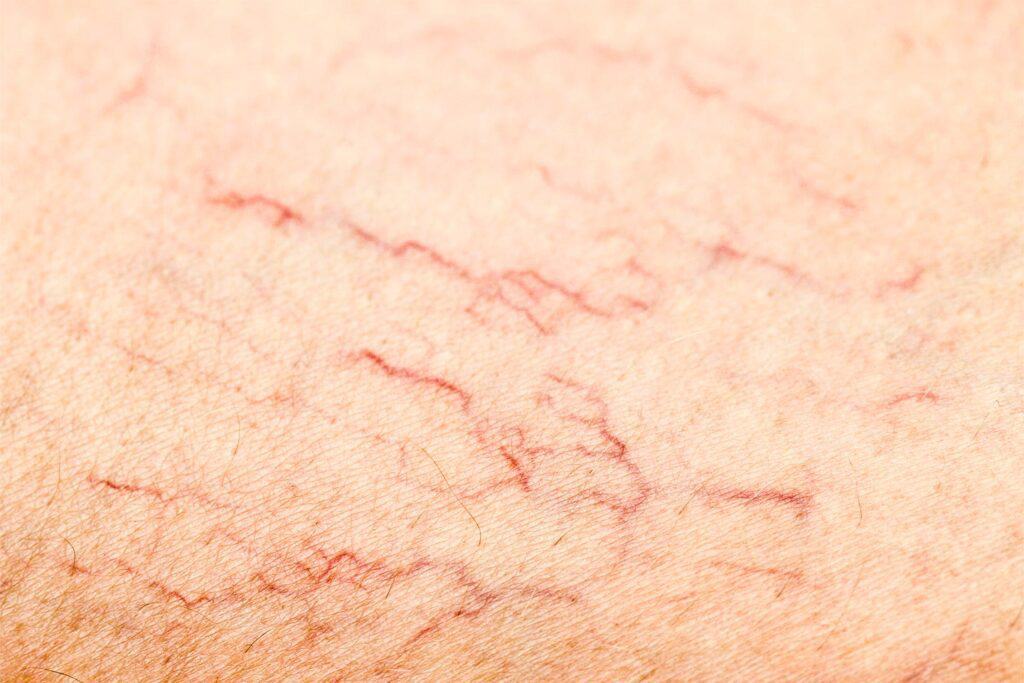Spider veins are small veins that are visible through the skin and appear in a weblike pattern. These fine, dilated blood vessels typically appear close to the surface of the skin, resembling spider webs or tree branches. They may look blue, purple, or red and tend to appear on the legs, ankles, feet, face, and pelvic area. While there are usually no symptoms associated with spider veins, they can rarely cause some discomfort – especially after standing for extended periods.
Lifestyle changes, such as maintaining a healthy weight and an active lifestyle, can help prevent or improve spider veins. Elevating your feet when sitting or laying down and wearing compression stockings can also help.
Their progression tends to be subtle at first, with tiny, thread-like veins gradually forming in clusters on the legs, face, or other parts of the body. Over time, these veins may increase in number and size, branching out further and becoming more noticeable.
Initially, spider veins might cause minimal symptoms beyond their appearance. However, as they progress, individuals may experience discomfort such as aching, itching, or burning sensations, particularly after prolonged periods of standing or sitting.
While spider veins are typically harmless, many seek treatment for cosmetic reasons or to alleviate symptoms. Various treatment options exist, including sclerotherapy, laser therapy, and vein stripping, each aiming to either close off or remove the affected veins.

Factors such as age, pregnancy, prolonged standing or sitting, obesity, and sun exposure can exacerbate the development of spider veins. They may persist or recur, underscoring the importance of preventive measures such as maintaining a healthy weight, regular exercise, avoiding prolonged periods of standing or sitting, and wearing compression stockings when necessary. Early intervention and lifestyle modifications can help manage their progression effectively.
Sclerotherapy is a minimally invasive option for treating small varicose and spider veins. It involves injecting a sclerosing solution into the vein, causing it to scar and collapse. This reroutes blood flow to healthier veins, leading the treated vein to fade over time. The procedure requires minimal recovery.
High ligation is a surgical procedure that involves tying off a damaged vein to redirect blood flow, and vein stripping refers to the removal of the damaged vein. In cases of advanced venous disease, our vascular surgeons may recommend high ligation and vein stripping as an outpatient procedure at a regional hospital. This procedure requires general anesthesia and is less commonly performed than other minimally invasive options, but it does have a high success rate and is the best option in some individual cases.
There are several options for how to get rid of spider veins. Common spider veins treatment methods include sclerotherapy, laser therapy, and in some cases, radiofrequency ablation. The best approach often depends on the size and location of the spider veins.
While both involve vein issues, spider veins are typically smaller, often appearing as thin red, blue, or purple lines close to the skin’s surface. Varicose veins are larger, swollen, and raised veins that can be flesh-colored, dark purple, or blue.
Spider veins on legs are quite common, but they can also occur on other parts of the body, such as the face.
Several factors can contribute to what causes spider veins, including genetics, hormonal changes, sun exposure, obesity, and prolonged standing or sitting. They are often considered a milder form of venous insufficiency compared to varicose veins.
Call now to book an appointment.
Conveniently located near Northgate Mall.